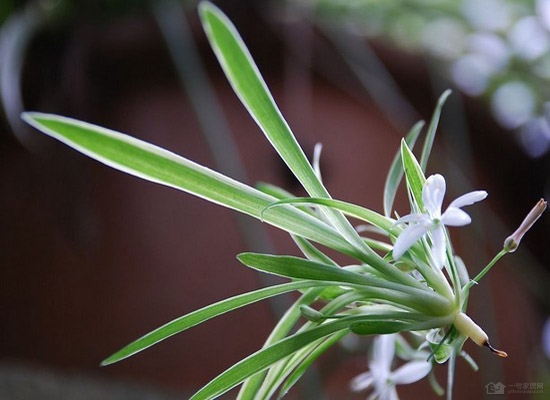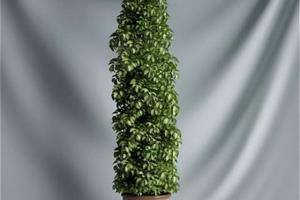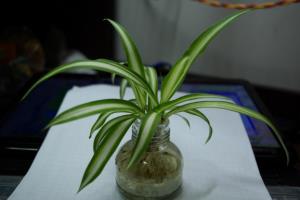How to plant orchids well and grasp the four key points of meticulous planting and breeding
Hanging orchid has a soft posture, green leaves drooping, dancing with the wind, like a beating crane, decorating the home, not only has ornamental value, but also has a good moral, very popular with friends. So, how to grow a good orchid? In fact, as long as you have a good grasp of the four key points of Cymbidium cultivation.

Hanging orchid, also known as weeping pot grass, laurel orchid, hook orchid, folding crane orchid, Western Europe, also known as spider grass or aircraft grass, originated in South Africa. Perennial evergreen herbs of the family Liliaceae. There are four main points to plant a good orchid.
I. change soil and basin
In order to achieve luxuriant stems and leaves in pot culture, the soil and basin should be changed once a year from March to April every year. If the basin is deeper and the base fertilizer is more sufficient, the basin can be changed once every two years. When turning the basin, knock the plant out of the basin, cut off the withered roots and excess roots, replace it with a new humus-rich culture soil, and then apply livestock hoof horns or rotten cake fertilizer as base fertilizer. After planting, put the seedlings in a warm and semi-overcast place. The most suitable growth temperature of Cymbidium is about 25 ℃. After the plant returns to robust growth, hang the flowerpot under the eaves of the corridor or in an appropriate position in the room. The general height is not to meet, and should pay attention to ventilation.
2. Proper lighting
Hanging orchids like a semi-overcast environment. Spring and autumn should avoid strong direct sunlight, the summer sun is particularly strong, can only see some oblique light in the morning and evening, need to cover 50% to 70% of the sun during the day, otherwise it will make the leaf tip dry, especially the flower and leaf varieties, more afraid of strong sunlight. Phnom Penh orchids grow more beautiful in places with weak light, yellow edges are more obvious, and leaves are brighter. But it should be more sunny in winter in order to keep the leaves tender and fresh green. The family potted orchid should be placed in front of the south window, otherwise the leaves will lose their luster and even wither.
3. Appropriate amount of fertilizer
Cymbidium is a more fertilizer-tolerant foliage plant, if the lack of fertilizer and water, it is easy to scorch head aging, leaves yellowing, loss of ornamental value. From late spring to early autumn, organic fertilizer can be applied every 7 to 10 days, but less nitrogen fertilizer should be applied to Phnom Penh, Jinxin and other mosaic varieties, so as not to fade or even disappear. The retting organic fertilizer such as bone powder and eggshell can be properly applied, and after full fermentation, take an appropriate amount of diluent and irrigate once every 10-15 days to make the flowers and leaves bright and bright.
IV. Proper watering
Hanging orchids like the humid environment, always keep the basin soil moist, adequate watering in summer, and spray water on the branches and leaves around noon and in the evening to prevent the leaves from drying up. There is often much dust in the room, such as more dust on the orchid, which not only affects the growth but also harms the freshness and freshness of the branches and leaves, so we should often spray and wash the branches and leaves to keep them bright and beautiful. The lower withered leaves and yellow leaves should be picked at any time, and the normal humidity should be maintained at ordinary times, not too dry or too wet.
For plants, water, soil, sunlight and fertilizer are essential. The same is true of hanging orchids, and they are easy to survive. As long as you plant carefully, the orchid will give you a green breath of spring.
Related
- Wuhan Hospital Iron Tree Blooming Result Was Instantly Frightened by the Gardener Master
- Which variety of camellia is the most fragrant and best? Which one do you like best?
- What is the small blue coat, the breeding methods and matters needing attention of the succulent plant
- Dormancy time and maintenance management of succulent plants during dormancy
- Minas succulent how to raise, Minas succulent plant pictures
- What are the varieties of winter succulent plants
- How to raise succulent plants in twelve rolls? let's take a look at some experience of breeding twelve rolls.
- Attention should be paid to water control for succulent plants during dormant period (winter and summer)
- Watering experience of twelve rolls of succulent plants
- Techniques for fertilizing succulent plants. An article will let you know how to fertilize succulent plants.



